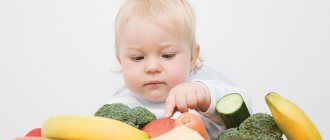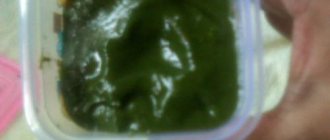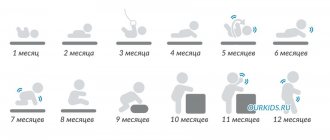A child’s menu at 9 months becomes much more varied - by this age the baby’s stomach works more smoothly, so it’s time to introduce the majority of healthy foods into the diet. This includes meat, fish, desserts, and dairy dishes. In general, what provides the baby with a supply of energy and nutrients for a more active knowledge of the world around him. Inexperienced mothers have a lot of questions - when should they start giving their baby what food, in what quantity, what dishes to prepare so that he eats new food with appetite? Today answers to these and many other questions will be given.
Features of the development and diet of a 9 month old baby
Feeding a child at 9 months becomes different than at 6 or 7 months; the baby has already tried many products, and parents regularly experiment with original recipes.
The main features include the fact that the baby no longer needs a large amount of mother’s milk (or artificial formula). He can wash down new dishes, as well as suckle before falling asleep, but complementary foods become the main food. At 9 months, babies become mobile - they sit, crawl, some begin to slowly stand and walk. Therefore, they need daily energy boost, which is provided by high-calorie and nutritious meals. Food should contain the maximum amount of vitamins, nutrients and minerals so that the body receives everything it needs for harmonious development.
Weight standards at 9 months
Weight norms in kilograms for a 9-month-old baby are presented below in the form of tables. You can consult with your attending pediatrician about whether your baby is gaining weight normally, but you can roughly compare the indicators yourself.
Table 1. Boy's weight at 9 months.
| Very low | Short | Below the average | Average | Above average | High | Very tall |
| 6,4 | 7,1 | 8,0 | 8,9 | 9,9 | 11,0 | 12,3 |
Table 2. Normal weight of girls at 9 months.
| Very low | Short | Below the average | Average | Above average | High | Very tall |
| 5,8 | 6,5 | 7,3 | 8,2 | 9,3 | 10,5 | 12,0 |
As you can see, girls can weigh a little less than boys at this age, but parents still need to take into account the individual characteristics of the child’s body. These are appetite, level of physical activity, absence or presence of chronic diseases.
Advice! If the child is healthy, but is not gaining enough weight for his age, you can increase the calorie intake or adjust the timing of feeding. You should also think about introducing new nourishing dishes that provide the baby with energy reserves and weight gain to get closer to normal.
What should not be included in a baby's menu at 9 months?
We have figured out what to feed a baby at 9 months, now we will look at foods that you should avoid. When a baby is less than 1 year old, you should not give him cow's milk, since it contains a large amount of calcium, which the kidneys, liver, stomach and intestines may not be able to cope with.
Also limit the amount of spices and do not add salt to your dishes. Refrain from sugar, choose children's juices, having carefully studied the composition; packaged juice “for adults” is not allowed for a baby at this age. The same applies to foods to which the baby has an allergic reaction; they should be excluded from the diet.
Diet
Complementary feeding for a child at 9 months should be of paramount importance, and the amount of breast milk or formula is reduced significantly. You should breastfeed or formula feed your baby in the morning and before going to bed; you can give a little milk after receiving the main dish. But only a small amount is acceptable.
During the day, a 9 month old baby should eat 5 times. Of these, two meals are liquid dishes, the remaining three are thick. The stomach takes more time to digest high-calorie foods, which provide the baby with energy reserves for a long time. Therefore, you should feed him at intervals of at least 4 hours. If your baby feels hungry, you can offer him fruit or baby cookies as a snack.
How much should a baby eat?
Optimal nutrition for a nine-month-old baby who is breastfed or bottle-fed should include a range of foods that are appropriate for his or her age. The table below will help you better figure out how to structure your daily menu. From it you can also find out the approximate amount of food that a baby should receive at 9 months.
| 06:00-07:00 1st breakfast | Mother's milk or formula – 200 ml | |||
| 10:00-10:30 2nd breakfast | Milk porridge – 180 gr. | Fruit puree – 50 gr. | Half an egg yolk | |
| 13:30-14:00 Dinner | Vegetable soup or puree – 180 gr. | Meat or fish in the form of puree (cutlets) – 50 gr. | Fresh fruit juice – 70 ml | A piece of bread or vegetable oil for dressing – 5 ml |
| 18:00-18:30 Dinner | Cottage cheese – 50 gr. | Kefir or fermented baked milk – 100 ml | Fruit puree – 50 gr. | Children's cookies or bread (slice) |
| 21:30-22:00 2nd dinner | Mother's milk or formula – 200 ml |
You can agree on a detailed menu with your pediatrician, taking into account the characteristics of the baby’s body, its preferences, appetite and energy needs.
WHO table for introducing complementary feeding
Starting from 9 months of age, complementary foods are considered the main food for the child. You can leave 1-2 breastfeedings for a breastfed baby or give a bottle-fed baby 1-2 cups of natural milk per day. So, what products, in what volume and age does the World Health Organization (WHO) recommend to introduce as complementary foods at 9 months? These data are reflected in the table.
| When? | What to feed? | How often? | How many? |
| 6-8 months | Thoroughly pureed, liquid food | 2-3 times a day. Additionally, 1-2 light snacks are possible during the day | 2-3 tablespoons at the beginning of the introduction of complementary foods. Increase to normal 125 ml per feeding |
| 9-11 months | Mashed, finely chopped food. Foods that your baby can hold in his hand | 3-4 feedings. Additionally, 1-2 light snacks are possible during the day | 125 ml of food per feeding |
| 12-23 months | Regular family food, chopped if necessary | 3-4 feedings. Additionally, 1-2 light snacks are possible during the day | 200-250 ml of food per feeding |
Important! WHO experts clarify that complementary feeding should be safe for the child, contain the maximum amount of nutrients and provide energy reserves. Parents should introduce the baby to new foods, maintaining his interest in food and the process of obtaining it.
Menu for toddlers while breastfeeding
What to cook for a 9 month old baby? A sample menu looks something like this.
- Dairy and dairy-free porridges
- Oil must be added to dishes
- Meat
- Vegetables, in the form of puree and soup
- Fruit, pureed or whole fruit
- Juices, compotes, teas
- Dairy products
- Bread
- fish
Prepare various porridges for your pet, if you have allergies, then dairy-free ones; if there is no such problem, then cook them with a mixture. Add butter.
Meat, it is best to give veal, rabbit, beef, chicken. You can buy ready-made canned food in the store or cook it yourself. You can make meatballs and cutlets from meat.
Give your child boiled vegetables, stew them, or steam them. Also be sure to prepare vegetable soup.
Fruit, pureed, or whole fruit. For example, by 9 months, a baby can already eat a banana, without chopping it.
Make compotes from dried fruits, give freshly squeezed juices, and children's teas.
Gradually introduce cottage cheese, yogurt, kefir, and cheese.
Give your child a piece of bread, a cracker, or a cookie.
Fish, both in pure form and in combination with vegetables.
All new products, as before, are introduced gradually, the reaction is monitored
How many times should you eat
The 9 month old toddler eats 5 – 6 times a day.
The power supply looks something like this:
- 6 am, mother's breast
- 10 am, porridge and fruit + kefir
- Dinner. Side dish + fish or meat. Vegetable soup
- Afternoon snack. It consists of some tasty snack, cookies, cottage cheese, yogurt + mother's milk
- Dinner at 6 pm. It could be vegetables.
- 10 pm, dinner. Usually this is mother's milk, but you can also give kefir.
Also, throughout the day, make healthy snacks, give your baby breastfeeding or formula.
In order to make your child's nutrition balanced, make it a habit to write out the children's menu for the week.
By the way: There is an opinion that it is better to introduce cottage cheese to breastfed babies from 9 months, although it is allowed from 6 months of age. Introducing this healthy product too early may result in excess protein.
For example, on Monday the baby eats oatmeal for breakfast, buckwheat on Tuesday, rice on Wednesday. Today applesauce, tomorrow peach, and so on with all meals.
A written menu will allow you not to repeat yourself and show your little one how varied food can be.
Subscribe to the newsletter and don't forget to share the article with your friends.
Bye!
Introduction of new complementary feeding products
It is necessary to create a menu for a child of 9 months gradually, introducing complementary foods with a minimum amount of a new dish.
If the baby is not yet familiar with the product, you need to monitor his reaction and not miss the moment of a possible allergic reaction. After newly introduced complementary foods, you should make an interval of 6-7 days and only then let the baby try a new dish. A breastfed or bottle-fed child of nine months can be taught to hold a spoon independently, thereby increasing his interest in the new diet. Let him even spill most of the food at first. The following describes the main types of nutrition that a baby at this age should already begin to master.
Meat
A child's diet at 9 months must include meat products. The meat must be chosen fresh and of high quality, boiled and then chopped. Which types can be used:
- veal;
- rabbit meat;
- chicken;
- beef;
- turkey.
Offal contains the maximum amount of the beneficial element iron. Despite the widespread belief that nine-month-old children should not be given the tongue, heart and liver of beef (chicken or rabbit), doctors advise introducing foods into the diet of children with low hemoglobin. It is better to make minced meat yourself, but meat puree in jars is suitable for traveling or visiting when there is no way to cook food.
Meat for the baby must be boiled and then thoroughly chopped
Fish
Regardless of whether the baby is bottle-fed or breastfed, at 9 months it is time to introduce fish into the child’s diet. White varieties with a low amount of fat are preferred - cod, pike perch, hake or flounder. Once a week you need to replace the meat dish offered to the baby for lunch with fish. First, the product is boiled and served along with vegetables. Then, when the child gets used to the taste of fish, you can make meatballs or cutlets from it.
Oil
It is important to include oils in your child’s diet. They can be plant or animal, since both contain the maximum amount of minerals, proteins, fats and vitamins necessary for the full development of the baby. The most beneficial oils for infants include:
- olives;
- corn;
- flax;
- sesame
It is preferable to add butter to cereal porridges, but vegetable oil perfectly complements vegetable puree - a teaspoon on a plate is enough.
Dairy products
The diet of a 9-month-old baby should be enriched with fermented milk products such as cottage cheese and kefir. They are considered the most suitable for this age, although many mothers already give their babies fermented baked milk at 7-8 months. The daily amount of cottage cheese is 50 grams, and the first portion of kefir is 30 ml. Gradually, the dose of kefir can be increased to 150-200 ml if the baby’s gastrointestinal tract responds well to the product.
On a note! Experts do not recommend giving more than 200 ml of kefir to a 9-month-old baby, since it contains a large amount of protein. Even if the baby eats cottage cheese with appetite, overeating will put an excessive burden on the kidneys, so you shouldn’t take risks.
Cow's milk
Many mothers overload the gastrointestinal tract of children at 9 months with a large amount of whole cow's milk, not knowing that it brings not only benefits, but also harm. It contains a maximum of protein, calcium and other substances
Porridge for a 9 month old baby: recipes
Porridge should be present in every child’s diet as breakfast. At 9 months, rice, corn, buckwheat, wheat, oatmeal and barley porridge are allowed. It is advisable to cook them in water without sugar until tender and only before turning off add a little milk or mixture, as well as butter. To diversify the taste of the porridge, add fruit puree or pieces of fruit to it if your baby has enough teeth.
Before you learn how to cook semolina porridge for a nine-month-old baby, think about whether you need it. Semolina contains a lot of gluten and phytin, a substance that interferes with the absorption of calcium in the body. Currently, pediatricians do not recommend introducing it into the diet of children under one year old.
But oatmeal for a 9-month-old baby will be healthy and tasty if you add additional ingredients to it:
- Oatmeal with fruit. Ingredients: oatmeal - ¼ cup, milk/mixture/water - half a cup, butter, fruit to taste (banana, apple, plum). Preparation: Add oatmeal to boiling milk/water mixture and cook over low heat until tender (7 - 10 minutes). Remove the porridge from the heat and leave covered. Mash a banana or plum, grate an apple on a fine grater and add the fruit to the porridge. If necessary, add butter and more milk for a thinner consistency.
- Rice porridge with pumpkin. Ingredients: 150 g pumpkin, 50 g rice, milk, water, butter. Preparation: Peel the pumpkin and cut it into cubes. Boil in water for 15 minutes, then add milk and rice. Cook for about 20 minutes, stirring constantly. Add butter to the prepared porridge.
- Wheat porridge with carrots. Ingredients: ½ cup wheat cereal, water, milk, half a carrot, butter. Preparation: peel the carrots, cut them into pieces and simmer in a small amount of water until half cooked. Add more water and milk (1 cm above the ingredients), butter, cereal and cook the porridge for 15 minutes.
In the section Raising children
to the question Moms, how do you cook soups for 9 month old babies?
asked by the author Valide
is I cook the meat separately - children cannot have broth, there are too many extractive substances that irritate the stomach and pancreas. I boil carrots, onions, zucchini and potatoes in water. Sometimes I add frozen dill (I grew my own in the summer). A little salt. Place the meat in a blender and finely mash the soup with a fork. It is better to give chicken after a year, and at 9 months - rabbit, turkey, and if this is not possible - veal. Well, fish 1-2 times a week. There is not very much meat in canned meat. Mostly starch or rice.
Reply from Jhosline
[guru] boil frozen salmon, a small piece of 150 grams in 500 ml of water. there are potatoes, rice (ground in a coffee grinder), carrots. then I crush 200 grams of this soup in a plate using a rolling pin. I make steamed meatballs in the same way - I add broccoli or cauliflower. cabbage (in jars) no reaction. 10 months for us. I don’t serve pork in any form. I often mix jarred ones.
Answer from Elena Buzunova
[newbie] The doctor introduced us to beef at 5 months, at 7 months I was already cooking soups in the same way with beef and chicken broth (I diluted the broth). Honestly, I don’t recognize jarred purees.
Reply from BAGI
[guru] I definitely cooked and still cook. At 9 months At this age, a blender is no longer needed, just mash with a fork and grind the meat in a coffee grinder. Boil the broth, then add carrots, onions, potatoes, noodles or rice, add a little salt….
Reply from Elena
[guru] Start with veal. Cook for 2 hours, then finely chop or grind. Chicken can cause allergies. and the soup is made with meat broth, boil the vegetables in it and grind them in a blender or with a spoon until mushy.
Reply from Yoolntse
[guru] Start with vegetable soup. For a 200g serving: 1 sprig of broccoli, one quarter of a medium potato, carrots (cm3-4 by eye), zucchini (50g), pepper for flavor (if frozen), add water and cook over low heat until boiling. Add a pinch of salt. Cool, mix in a blender. Before switching to meat soup, a week after taking vegetable soup, add a level tablespoon of cereal (buckwheat, rice...), and a week later - a teaspoon of vegetable oil (preferably olive) and only then can you safely move on to meat soups . Meat. Buy meat (veal, rabbit), make minced meat, form it into balls (4 grams = small walnuts), put it on a plate and in the freezer, it will freeze, put it in a bag and store it in the freezer (convenient and practical). For the first preparation of meat soup, one ball (meatball) is enough. Cook like vegetable soup, but when it boils, throw in the meatball, it will float to the top and it’s ready. Fish (hake, admiral... not fatty fish)... cook like meat soup.
Sample menu
The menu for a 9-month-old baby on artificial feeding is no different from breastfeeding infants. In order not to get confused and prepare original dishes for your little ones, you can create your own menu. Or use the approximate diet plan for a 9-month-old child who is bottle-fed, proposed in the table.
| Monday | Lunch | Semolina porridge + dried fruits, cottage cheese with peach, pear puree |
| Dinner | Pumpkin and cabbage puree, half an yolk, chopped turkey meat, compote, bread | |
| Afternoon snack | Buckwheat porridge, yogurt, applesauce, cookies | |
| Tuesday | Lunch | Buckwheat porridge + pumpkin, plum puree, cottage cheese |
| Dinner | Soup with meatballs, onions, carrots, herbs and potatoes, pear-peach puree, bread | |
| Afternoon snack | Oatmeal, kefir, baked apple | |
| Wednesday | Lunch | Rice pudding, curd soufflé, jelly |
| Dinner | Pumpkin soup, fish cakes, bread, fruit juice | |
| Afternoon snack | Yogurt, corn grits porridge with fruit, crackers | |
| Thursday | Lunch | Oatmeal with berries, cottage cheese, prunes |
| Dinner | Broccoli puree, rabbit meat, peach puree, fruit juice, bread | |
| Afternoon snack | Rice porridge, cookies with kefir | |
| Friday | Lunch | Corn grits porridge with pear, cottage cheese, apple puree |
| Dinner | Chicken soup, pear puree, bread, berry juice | |
| Afternoon snack | Barley porridge, yogurt, cookies | |
| Saturday | Lunch | Buckwheat porridge with peach, cottage cheese, fruit juice |
| Dinner | Turkey with zucchini and carrots (puree), bread, baked apple and berries | |
| Afternoon snack | Oatmeal, apple puree, kefir, crackers | |
| Sunday | Lunch | Barley porridge with pumpkin, cottage cheese with plums, fruit jelly |
| Dinner | Beetroot soup, fish puree, peach and pear mixture, compote | |
| Afternoon snack | Yogurt with pear pulp, buckwheat porridge, cookies |
The approximate menu for a week for a 9-month-old baby on artificial and breastfeeding, given above, can be supplemented with your own recipes, making the diet more varied.
Soup for a 9 month old baby: recipes
The first dish should already be present in the baby’s diet. In this case, you need to know how to cook soup for a 9-month-old baby. This should only be done with vegetable broth. Meat broth is very difficult for a child’s digestive system and can cause allergies due to the extractive substances it contains. Accordingly, we cook meat and fish separately from the soup and add already chopped ones to it before serving.
Vegetable soup for a nine-month-old child may include the following components: potatoes, carrots, onions, white cabbage, cauliflower and broccoli, zucchini, pumpkin, peas. All vegetables are added gradually in groups: for example, first cabbage, a few minutes later carrots, then potatoes. Soups should be salted a few minutes before turning off. Children under one year old are advised not to add salt to their first courses at all.
So, what could be a delicious soup for a nine-month-old baby? Interesting recipes:
- Vegetable puree soup with liver. Ingredients: small zucchini, small onion, half a carrot, several cauliflower florets, potatoes, chicken liver. Preparation: Prepare the vegetables by washing, peeling and cutting them into pieces. Place liver, onion and carrots in a saucepan, bring to a boil and add potatoes. After 10 minutes, add the zucchini and cabbage to the pan and cook for another 7 minutes. Remove from heat, cool slightly and puree in a blender. Add butter and, if desired, dill to the finished soup.
- Soup with rice and cauliflower. Ingredients: a pinch of rice, cauliflower, carrots, vegetable broth, 5 g cream (or milk/mixture). Preparation: Cook rice and vegetables separately until cooked. While hot, rub them through a sieve, dilute with vegetable broth and boil. Before turning off, add cream, regular or mother's milk, or formula.
- Pumpkin soup. Ingredients: 150 g pumpkin, half a carrot, 1 potato, olive oil. Peel the vegetables, cut the potatoes and pumpkin into small cubes, grate the carrots. Place all ingredients in boiling water and cook until tender. Grind them with a blender, adding broth to the desired consistency, and add butter before serving.
Dish recipes
What to feed a 9-month-old baby who is bottle-fed or breast-fed, and what volume of food to give is now clear. Now we need to take a closer look at the recipes for children's dishes, which many mothers can take on board if they do not know how best to combine foods for breastfed and bottle-fed babies.
Soups
The diet of a nine-month-old child who is bottle-fed or breastfed must include soups. Here are a few original recipes that your little ones will surely love:
- Green pea puree soup – combine 2 tbsp. peas with 1 tbsp. rice, mash, pour a spoonful of broth, cook and season with butter;
- vegetable with beets - boil 30 g. beets, a quarter of carrots and onions, a couple of potatoes and cauliflower inflorescences. Mash the vegetables and pour in the broth, add a spoonful of butter;
- chicken soup – cut 70 gr. chicken fillet, boil for 10 minutes, add greens, 30 g. Carrots, onions and potatoes. After cooking, mash with a blender.
Soups can be prepared from different vegetables, but the most useful are pumpkin, cabbage, beets, and carrots. Meat broth should be diluted with water in half, and vegetable broth should be seasoned with puree.
Porridge
Cereal porridges are a favorite dish for children aged 9 months, as they are varied and are introduced early into the diet. The healthiest and most delicious porridges for babies:
- corn with the addition of pear - pour one glass of cereal with ½ glass of water, cook for ¼ hour, add grated pear to the finished dish;
- buckwheat with pumpkin – 50 gr. Boil the cereal for 12 minutes in 100 ml of water, boil for 20 minutes and add the grated pumpkin to the same plate;
- rice with milk - add rice to boiling water (half a glass), cook for 20 minutes, season with milk, stir and throw in a piece of butter.
Buckwheat is useful for children with low hemoglobin; doctors recommend giving it more often, alternating cooking with water and milk.
Meat and fish dishes
You can cook soup from meat and fish with the addition of vegetables, or you can prepare a second dish, for example, cutlets. Take pollock or hake, grind it in a blender along with carrots and onions (quarters each), and add a tablespoon of oatmeal. The formed cutlets are steamed for 15-20 minutes.
Need to know! Meat cutlets are prepared according to the same principle. You can make steamed meatballs by adding a little boiled rice to the selected double-twisted meat. It is good to serve green peas, mashed potatoes, cabbage or carrots with them.
Vegetable dishes
Vegetables for 9 month old babies are often prepared in the form of puree. The most common cooking options:
- carrot - peeled and washed vegetables are grated, boiled under a lid for 30-40 minutes in a small amount of water, then rubbed on a sieve and combined with 2 tbsp. semolina porridge. The dish brought to steam over the fire is seasoned with oil;
- mixed puree - carrots, rutabaga and cabbage are mixed and pureed. Next, mix with hot water and simmer under the lid. After adding chopped potatoes, the dish is kept on the fire until cooked. Add oil to the hot mashed puree;
- potato – 250 gr. The root vegetable is boiled, then mashed, mixed with ½ cup of milk, salted and whipped with butter.
Vegetables such as cabbage, zucchini, and broccoli can be served as side dishes for meat and fish dishes.
Fruit dishes and desserts
Your child will surely love getting an apple-curd soufflé for dessert. It is prepared like this: mix semolina (2 tsp), one chicken egg, 5 g in a blender. butter, peeled apple and cottage cheese (2 tbsp). Next, the mixture is placed in the oven for a quarter of an hour - the soufflé is ready.
You can bake an apple - make a hole in the middle of the fruit and place fresh berries there. Cherries and black currants are suitable. Cover the oven tray with foil, place an apple filled with berries on it, set the temperature to 160°C and bake for 20 minutes.
For dessert, you can also serve a salad - different fruits are used to prepare it. For example, take a banana, apple, pear and carrot, mash with a fork or grind in a blender, season with a little honey. If the mixture turns out thick and heavy, you can add a little homemade yogurt instead of honey.
Soups
Soup “Joy”
Liquid food is very important for babies under one year old, so soups containing vegetables: pumpkin, potatoes, onions will be easily digested in the baby’s stomach and will bring maximum benefit to the entire body.
| Required Ingredients | Preparation |
| It is necessary to immediately put all the ingredients into boiling water, with the exception of sorrel, add a saline solution and cook until tender. Then you should lower the sorrel, let the soup boil and immediately turn it off. You need to drain the water and beat the remaining grounds with milk using a blender. Season the soup with butter before serving. |
Avoiding night feedings
Upon reaching 9 months of age, the child should stop eating at night. Most babies independently refuse to feed at night, but in the morning, around 6-7 o’clock, they wake up with a loud cry, making it clear that they are hungry. However, some babies even at 9 months require a snack in the dark.
If the child has a good appetite, and during the day he actively eats the food that is offered to him, it is worth consulting with the pediatrician whether the baby’s weight allows us to wean him off nighttime feedings. The doctor will give advice on how best to do this, evaluate the baby’s nutrition at 9 months and tell you whether a child of a certain weight should be denied an additional snack.
How to wean your baby off night feedings?
Often the reason that a 9-month-old child with good weight gain cannot be weaned from night snacks for a long time is the wrong tactics of the parents. Many mothers, hearing that the baby has begun to groan and toss and turn in the crib, immediately run to him with a bottle of formula or offer the breast. Although many children, having been a little capricious (waking up not from hunger), calmly fall asleep again and do not disturb their parents until the morning.
In such a situation, if the baby ate well during the day and had a hearty dinner, you should give him a bottle of water and then rock him in your arms. In the first 2-3 nights, the baby may cry even for 15-20 minutes straight, but don’t give up. Over time, he will get used to supplementing with water, and then he will completely stop waking up at night.
Recommendation! If your baby cries at night for several nights in a row, and a bottle of water and rocking him to sleep do not help, perhaps he really does not get enough to eat during the day. It is worth reevaluating the diet, adding high-calorie dishes to it so that the baby remains full throughout the night.
Child's daily routine
4 months
At this age, children cannot yet live according to a clear daily routine by the hour, since they still sleep short naps during the day and are not able to stay awake for a long time. Therefore, the daily routine at four months. is based on waking time, which is no more than 1.5-2 hours between dreams. At the same time, an infant needs 9-10 hours of sleep per night with awakenings for feedings and 3-4 daytime naps with a total duration of about 4-5 hours, that is, the baby will sleep with this schedule 3-4 times a day. Evening bedtime will vary and depend on the end of the last nap of the day. To put your child to bed on time, be guided by signs of fatigue and do not exceed the waking time of more than 2 hours. This way you will prevent your baby from overtiring, which will improve the quality of his night sleep and reduce the number of night awakenings. The morning should start no later than 7.00-7.30 in order to form a physiological daily routine.
How many feedings does a baby need at night?
For a four-month-old baby, breast milk or formula is still the main food in his diet.
A breastfed baby's diet this month will consist of feedings every 3-4 hours. The volume of breast milk you drink at one time will be about 118-210 ml. The duration of feedings may vary.
When bottle-fed, the volume of the formula should be calculated based on the pediatrician’s recommendations. This is usually 1/6 of the child's actual body weight. At four months the baby will eat 800-1000 ml. mixtures per day every 3-4 hours during the day.
The baby is increasingly showing interest in the world around him and during feeding may begin to be distracted, not finish eating and replenish hunger at night. Therefore, it is better to feed the baby in a calm environment.
Does your baby wake up at night shortly after feeding and start crying? It is better not to feed him again, but to try to calm him down in other ways, for example, patting his tummy and shushing him. This way, the baby will not develop the habit of falling asleep only with the help of feeding.
Should we start complementary feeding at 4 months? WHO (World Health Organization) recommends introducing complementary foods from 6 months. Therefore, before introducing adult food, you should consult your pediatrician.
Physical development of a 4 month old baby
The fourth month is the age when the child can already do a lot and master new skills.
He already confidently uses both hands at the same time - he grabs toys, colored and shiny objects next to him. Soft books and teething rings are good choices for this age.
For reading, choose large books with different textures inside to develop tactile sensations. Read and sing to your baby for a few minutes every day
This develops the child's attention and speech. Take a closer look at children's bathing books—their puffy pages are easy to flip through
In addition, they often squeak, and the pictures in them are bright.⠀
The baby already holds his head and chest well, being on his stomach and pushing off the surface with his hands. Also, the child may already begin to roll over from his stomach to his back and push with his legs.
From the age of 4 months, the baby's first teeth erupt. If your baby's salivation increases, redness appears around the mouth, he begins to bite, refuses to eat, becomes capricious, and his sleep at night has worsened, then most likely the child is getting a new tooth. During the acute period, teething rings, anesthetic gel as recommended by the pediatrician, and more attention and warmth from the mother will help.
Important changes also occur in communication with your baby at 4 months. He realizes that his mother is responding to his crying, and begins to use different sounds when communicating with others: ooo..., aah..., ahu... Catch the moment when the child “talked” more than usual and play “echo” with him. He says - you repeat.
This game gives the baby confidence that his mother is listening to him and is happy to talk to him. And of course, it develops the child’s speech. Try it - you will like it.
Also, at this age, finger games will already be useful, for example, “Ladushki”, “The Horned Goat is Coming”, “Magpie-Crow” - they are aimed at developing the child’s fine motor skills, which in turn is important for the formation of speech. What is your baby's daily routine at 4 months?
What is your baby's daily routine at 4 months?
Did you like the article? Rate:
Votes: 161
Nutrition tips for moms
The nutrition of 9-month-old children who are on breastfeeding and artificially fed children is no longer fundamentally different; only for breakfast and before bedtime, some receive breastfeeding, while others receive formula. The main advice for parents is to carefully monitor the baby’s reaction to new foods, since even a harmless vegetable can cause allergies. List of recommendations for feeding a 9 month old baby:
- accustom the child not only to pureed food in the form of puree, but also to chopped food with a fork - he must learn to chew;
- to diversify dishes, you can add fruit to porridge or cottage cheese, and not just give it in the form of puree or juice;
- Feed your baby only fresh and high-quality products; when purchasing ready-made food, pay attention to expiration dates.
At 9 months, most babies already have their front teeth, so you can let them chew on an apple or pear under the supervision of their mother.
What should a mother do if her child refuses complementary feeding?
Not all babies react the same way to the introduction of new foods into their diet. If a child does not like the taste of a certain dish (fish, cottage cheese or vegetables), you should not force feed him. You should offer him the same food a few days later, flavoring it with the usual side dish. You can give the baby a spoon so that he can try a new dish on his own; perhaps this will awaken interest in food, and it will no longer seem so tasteless.
Proper and balanced nutrition is the key to the harmonious development of the baby, along with physical activity, walks and fun games. As new dishes are introduced, the child’s food horizons expand, he begins to hold food on his own, and eats from a spoon. It is too early to feed a baby who is still drinking mother's milk with adult food. Moreover, you should not give him over-salted, fried or smoked foods. How to properly feed a baby at 9 months, what to cook and how to preserve the nutritional value of dishes? This article gives many recommendations, following which every mother will be able to serve her baby delicious food for his full development.











